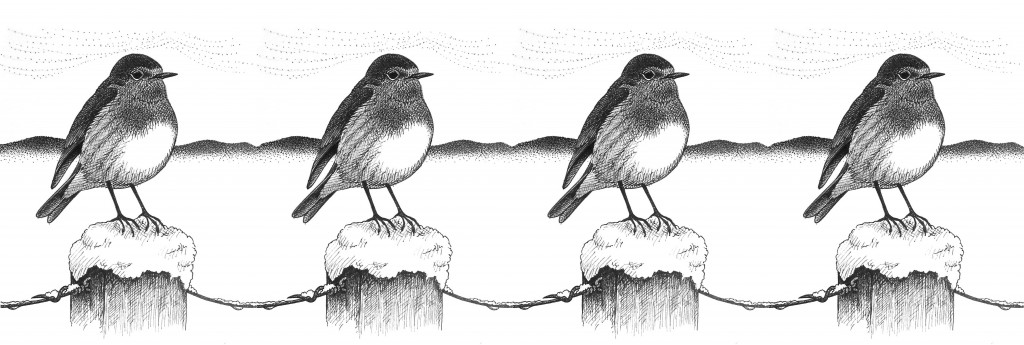|
The bird lands in the willow just outside the dining room. Or at least, the bird appears in the willow. I do not see it land. One moment I am reading beside the window and there is no bird. The next I have stopped reading.
It stands on a thin branch, somewhere close to the centre of the tree. Cocked, its slim tail twitches up and down, not quite rhythmically. Each movement is sudden and convulsive. It looks about, then bows, dipping and lifting its head in an instant. Then it calls: a single, high-pitched chkk. It calls again: chkk-chkk. With each sound, the tail jerks, steadying the bird and keeping it from capsizing. It bows further, wipes its tiny beak on the branch – one side then the other – turns and calls again. Shifting direction gradually, it shouts a wall around the garden, then pauses, waiting for a challenge. There is an unmistakable hint of arrogance in its stance – the head is held high, the orange-red breast is plumped up and puffed out defiantly. “This is my place”, it seems to say. “I live here.” There are few birds so widely recognised or so well loved as the robin. There are few birds, too, so emblematic of one particular time or season. For though it is a year-round British resident, the robin is most fondly thought of as a winter bird. Here in Shetland that is even more true than elsewhere. Only a tiny number of robins, if any, actually breed in the islands, but from late autumn those few residents are joined by an influx of migrants from Scandinavia. Some of these birds will stay only briefly, but others remain until spring. Winter is their season. Robins appeal to that part of us that is beguiled by simple things: bright colours, funny walks, amusing characteristics. We enjoy them because they catch our eye, and in doing so invoke some kind of strange empathy. A dead robin on the doorstep somehow seems more tragic than a dead sparrow. This feeling is all the more peculiar since we face a problem when looking at birds: how do we separate the individual from the general? I can sit and watch this robin outside my window for five minutes, ten minutes, half an hour. I can describe its behaviour, and note down the details of its appearance – the sweet red-orange of its breast, neck and forehead; the grey outline of its face; the flash of white belly; the nervous posture. But this picture will always be lacking. When the bird flies and I am left only with my words, they seem no more specific than the illustrations in my guide book or on my Christmas cards. Robins on garden gates. Robins on fence posts. Robins on snow-draped branches, flanked by mistletoe. Is it possible to tease out one bird from these dense layers of images? Can we understand this single robin without reducing it to the generic one that each of us carries in memory and imagination? For the most part, our understanding of individuality is tied up with intelligence. The difference between looking at a robin and looking at a raven, say, is that while the larger bird may see its world quite differently from the way that we see ours, the raven’s gaze is nonetheless recognisable. There is something like thought going on behind those eyes; and where there is thought, there is personality. In the robin, I do not see thought; I see only an indecipherable code of action and reaction. So what, then, is a robin? What is this tiny creature that stands and sings and flies and feeds? The truth is that, amputated from its perch, that robin may be less than we imagine. Written or drawn from the tree onto the page, the bird becomes something other than what it is. For what it is, to some extent, is there in that tree. Barry Lopez once wrote that an ‘animal’s environment, the background against which we see it, can be rendered as something like the animal itself – partly unchartable. And to try to understand the animal apart from its background, except as an imaginative exercise, is to risk the collapse of both. To be what they are they require each other.’ This bird, like all birds, like all living things, is defined by its context – by its place. While it is here, the robin is part of the garden and the garden is part of the robin. Both are entwined in a way that reaches beyond observation and certainly beyond description. It is a relationship that goes to the heart of what it means to be at home. For a time the bird is gone, somewhere unseen, though I continue to watch the branch where it had stood. A few minutes later it returns and begins to call again: chkk-chkk. The robin’s little tail lifts and falls; it wipes its beak; it looks around; it calls again; it flies. I return to my book. Comments are closed.
|
The Things Around MeThe Things Around Me is the story of a Shetland garden, written by Malachy Tallack and illustrated by Will Miles.
Archives
October 2016
|

 RSS Feed
RSS Feed